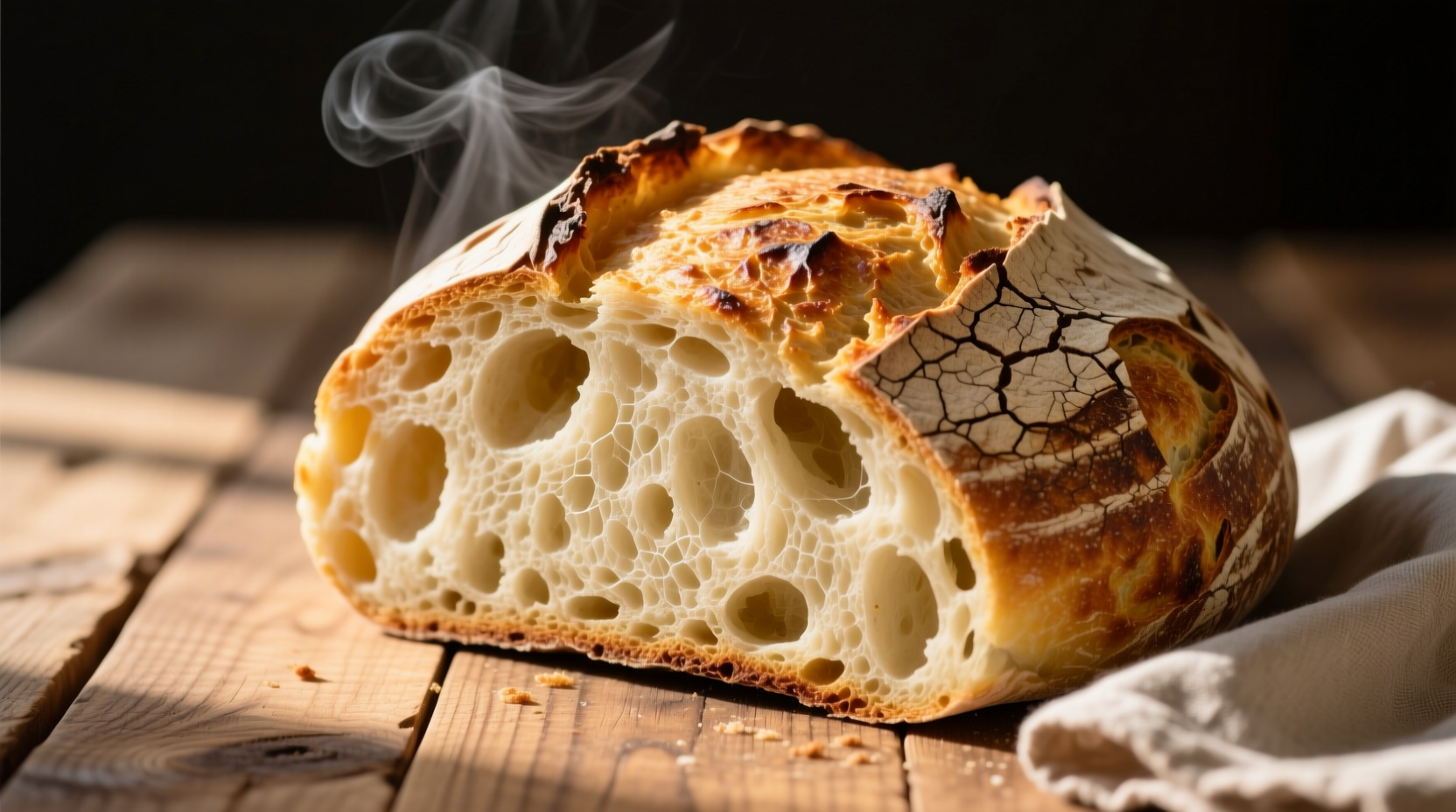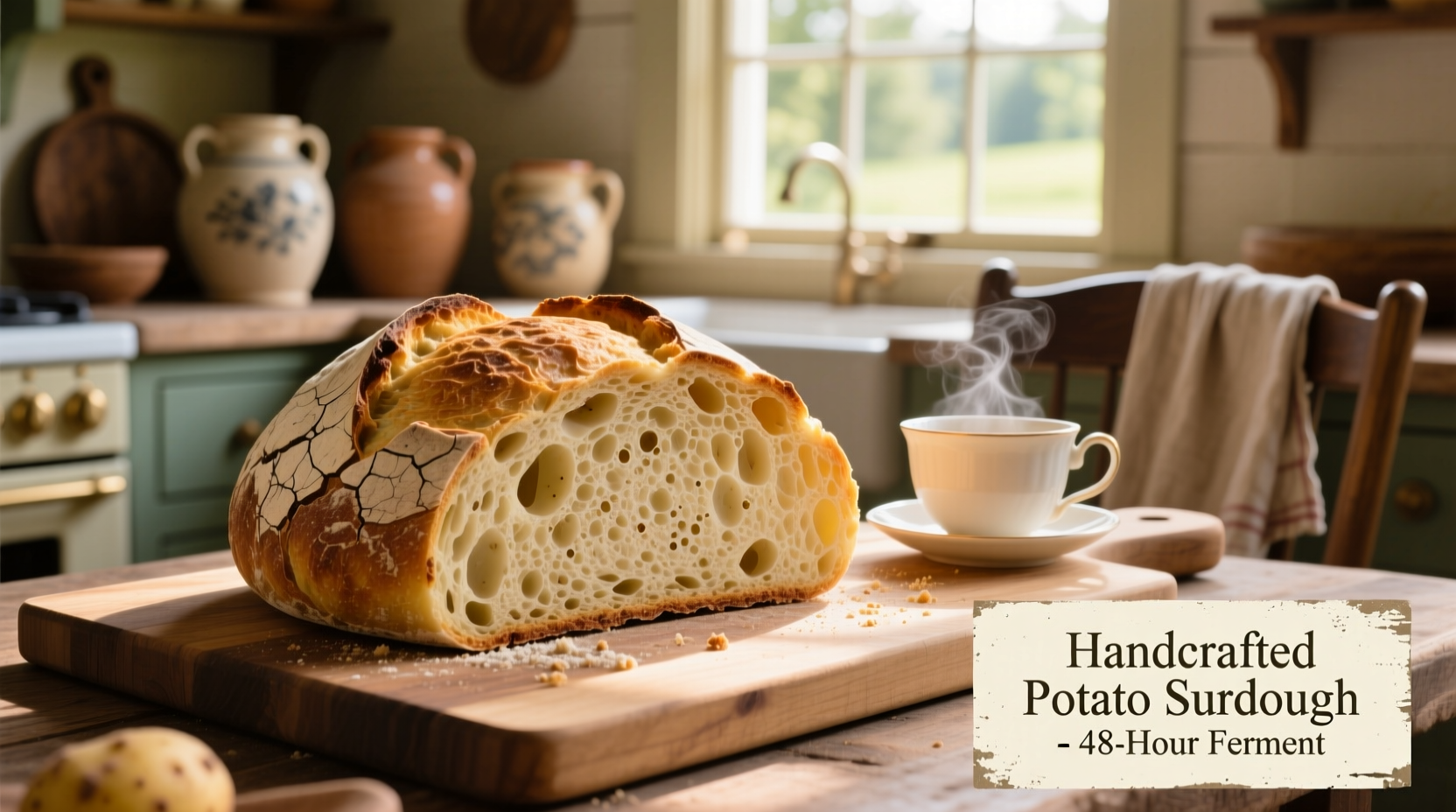The Science Behind Potato Sourdough's Superior Texture
When you incorporate potato into your sourdough, you're leveraging centuries of baking wisdom backed by modern food science. Potato starch has a remarkable ability to absorb and retain moisture—up to 4 times its weight in water—creating bread that stays supple long after cooling. Research from the USDA Agricultural Research Service confirms that potato starch forms a stable gel structure that delays staling by slowing retrogradation of wheat starch.
| Characteristic | Regular Sourdough | Potato Sourdough |
|---|---|---|
| Shelf Life | 2-3 days | 4-5 days |
| Crumb Moisture | 60-65% | 68-72% |
| Acidity Level | Higher | Moderated |
| Crust Color | Deep brown | Golden brown |
Unlike commercial bread improvers, potato works naturally with your sourdough ecosystem. The natural sugars in potato provide additional food for your starter's wild yeast and bacteria, creating a more vigorous fermentation without compromising the complex flavor development. Studies in the Journal of Food Chemistry demonstrate that potato-amended doughs show 15-20% increased gas retention during proofing, directly contributing to that desirable open crumb structure.

Three Proven Methods for Incorporating Potato
Professional bakers use three primary approaches to introduce potato into sourdough, each with distinct advantages for different baking goals:
1. Potato Water (Traditional European Method)
Boiling potatoes creates starch-rich cooking water that's perfect for hydration. This method, documented in 19th century European baking texts, provides subtle flavor enhancement without significantly altering dough hydration. Simply substitute 25-50% of your regular water with cooled potato water for noticeable improvements in texture. The University of Minnesota Extension notes this technique was particularly valuable in pre-refrigeration eras when preserving bread was critical.
2. Mashed Potato (Maximum Moisture Retention)
Adding 50-100g of smooth, cooled mashed potato per 500g of flour creates the most dramatic shelf-life extension. For best results, use russet potatoes which have higher starch content than waxy varieties. This approach works exceptionally well for sandwich loaves and dinner rolls where moisture retention is paramount.
3. Potato Flour (Precision Control)
For consistent results, substitute 5-10% of your total flour weight with potato flour. According to standards from the American Association of Cereal Chemists, potato flour contains approximately 80% starch compared to wheat flour's 70-75%, explaining its superior water-binding properties. This dehydrated option provides all the benefits without introducing additional moisture variables.
Perfect Potato Sourdough Recipe for Home Bakers
This tested recipe delivers professional results with home kitchen equipment. The key innovation is using potato water as the primary hydration source, which provides starch benefits without complicating dough handling.
Ingredients
- 500g bread flour
- 300g potato water (from boiling 200g potatoes)
- 100g active sourdough starter
- 10g sea salt
- 50g mashed potato (optional for extra moisture)
Step-by-Step Process
- Prepare potato water: Boil 200g peeled russet potatoes in 400g water for 20 minutes. Cool to room temperature.
- Mix dough: Combine 300g cooled potato water, 100g starter, and 500g flour. Autolyse 30 minutes.
- Add salt: Mix in 10g salt and optional mashed potato. Perform 4 sets of stretch and folds over 2 hours.
- Bulk fermentation: 4-5 hours at 75°F (24°C), with folds at 30, 90, and 150 minutes.
- Shape: Pre-shape, bench rest 20 minutes, then final shape into boule or batard.
- Proof: 2-3 hours at room temperature or overnight in refrigerator.
- Bake: 450°F (230°C) for 20 minutes with steam, then 400°F (200°C) for 25 minutes uncovered.
Troubleshooting Your Potato Sourdough
Even experienced bakers encounter challenges with potato sourdough. Here's how to solve common issues:
Dense Crumb Despite Good Oven Spring
This typically indicates under-fermentation. Potato's additional sugars can accelerate fermentation, but the increased moisture content requires slightly longer bulk fermentation. Extend bulk fermentation by 30-60 minutes and ensure your dough has increased by 50% in volume before shaping.
Excessive Stickiness During Handling
Potato increases effective dough hydration. If your dough feels too wet, reduce potato water by 10-20g in your next batch. Alternatively, perform an additional set of stretch and folds during bulk fermentation to strengthen the gluten structure.
Mildly Sweet Flavor Overpowering Sourdough Tang
The natural sugars in potato can mellow the sourdough's characteristic acidity. For more pronounced sourness, extend your bulk fermentation at a cooler temperature (70°F/21°C) or use a more mature starter (fed 12 hours prior).
When Potato Sourdough Works Best (Context Boundaries)
While potato sourdough offers remarkable benefits, it's not universally appropriate. Understanding these context boundaries will help you decide when to use this technique:
- Ideal for: Sandwich loaves, dinner rolls, and breads meant for toasting where moisture retention is valuable
- Less suitable for: Crusty artisan loaves where maximum oven spring and open crumb are primary goals
- Special consideration: In humid environments, reduce potato water by 10-15g as ambient moisture affects dough hydration
Historical context shows potato bread gained popularity during the Irish Potato Famine as a way to stretch limited grain supplies. The UK National Archives document recipes from 1847 where potato constituted up to 30% of the total bread ingredients. Modern bakers have refined this technique to enhance quality rather than just quantity.
Storage and Serving Tips for Maximum Enjoyment
The moisture-retaining properties of potato sourdough change how you should store and serve it:
- Cool completely on a wire rack before storing to prevent condensation
- Store cut-side down on a wooden board (not in plastic) to maintain crust integrity while preserving crumb moisture
- Revive stale bread by misting with water and reheating at 350°F (175°C) for 5-7 minutes
- Freeze whole loaves wrapped in parchment and foil for up to 3 months
When serving, potato sourdough's subtle sweetness pairs beautifully with both sweet and savory applications. Try it with smoked salmon and cream cheese, or toasted with a drizzle of honey for breakfast. The enhanced moisture content makes it particularly suitable for paninis and grilled sandwiches that would dry out regular sourdough.











 浙公网安备
33010002000092号
浙公网安备
33010002000092号 浙B2-20120091-4
浙B2-20120091-4